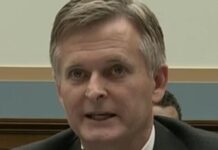Accuse Representative Seth Moulton of loving trains too much at your peril. Yes, the Massachusetts Democrat worked for a time on a high-speed-rail project in Texas, one that is now finally inching towards a groundbreaking ceremony. He’s pressed for a new rail tunnel in Boston. He’s a booster for commuter rail. But ask him why he loves trains, and he’ll correct you, firmly. “It’s not that I just like trains so much,” he says. “We should have a transportation system that’s balanced and gives people options.”
On Tuesday, Moulton unveiled an ambitious—and expensive—plan to do just that. In a bill and accompanying white paper, the congressman proposed the federal government spend $205 billion over five years on a national high-speed rail network. That money could, in turn, encourage another $243 billion in matching state, local, and private investments, Moulton says. The bill would create a unified, national vision of a rail network that could guide future investments, and would iron out regulations, to speed construction. It would encourage private companies to operate the new rail networks, instead of, say, Amtrak, which is projecting a $700 million loss this year. It cites firms like Virgin Trains USA, which runs and hopes to extend a rail line in Florida, and Texas Central Railway, Moulton’s former employer, which is working to build one in the Lone Star State, as models.
Enough with the money stuff and picture this: Dallas to Houston without the 3.5-hour car ride. Chicago to Atlanta, with fewer weather delays and stops in Indianapolis and Chattanooga along the way. Portland to Vancouver at 220 mph. LAX to SFO—the busiest domestic airline route in the US—in under three hours without actually entering the cursed departure or arrival halls. Less pollution (these rail lines would be electric), and fewer deaths (no one has died on the Japanese Shinkansen high-speed rail system in its 55-year history, compared with 36,120 on American roads last year alone). A wide, cushy seat with plenty of legroom, the sun shining through the windows.
The expansive vision is sure to face stiff opposition and test Washington’s appetite for a pricey, infrastructure-based stimulus package designed to counter the pandemic-induced economic downtown. In late March, President Trump signaled on Twitter that he was interested, hyping support for a “VERY BIG & BOLD” plan focusing on “rebuilding the once great infrastructure of our County!” (He meant “country.”) But in a statement last week, the president’s Office of Management and Budget listed its top stimulus priorities as payroll tax holidays, releasing companies from liability, and “permitting reform to facilitate infrastructure projects”—a far cry from a bold and wide-ranging infrastructure program. Congress-watchers say Republican enthusiasm for writing such a check is waning, and fast.
Still, Moulton’s plan echoes ideas bouncing around in transportation policy circles. The pandemic has changed the way house-bound Americans work and play. Streets have been emptied as all but essential workers have halted their daily commutes. Those who can have switched from public transit—tight corridors, surfaces teeming with who-knows-what—to bike, walk, maybe even scooter trips. For many in policymaking circles, the pandemic is a tabula rasa, a moment to rethink the status quo of transportation and development dominated by the car. Why not more bike lanes? Why not more scooters? Why not high-speed rail?
One reason is that Americans seem to have collective high-speed-rail PTSD, a hangover from the big California project that has, in many ways, gone off the rails. After years of delay and cost overruns, the project meant to ferry riders between Los Angeles and San Francisco is now expected to cost more than $80 billion and open in 2033, 25 years after California voters approved its funding. Moulton’s team says it has taken away a whole bunch of “lessons learned” from the California debacle, which it plans to apply to the new scheme.
The Obama administration’s 2009 stimulus included $8 billion for high-speed rail, targeted towards so-called “shovel ready” projects. But the program was slower to get off the ground than other elements of the transportation stimulus, in part because it was new and needed to be designed. An analysis by Jeff Davis, a senior fellow at the think tank the Eno Center for Transportation, found the Transportation Department’s Federal Rail Administration had spent just 19.2 percent of its allocated high-speed rail funding by the beginning of 2014, when most other parts of the infrastructure stimulus was long spent. Even the more “conventional” parts of that stimulus, like $27.5 billion dedicated to highways, took a while to trickle down to the every-day American. A report published by the Congressional Research Service this month found that the employment effects of the stimulus were “relatively modest,” and mostly seemed to help states and municipalities keep their workers rather than add new ones.









